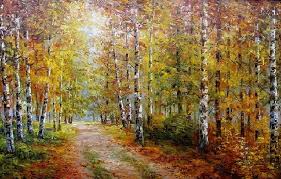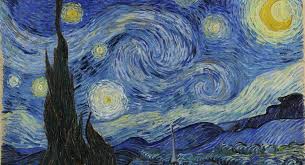OIL ART PAINTS (part 2)
 You probably noticed that the colors on the palette soon stop getting dirty, but if you slightly press on them with your finger, you can make sure that they are soft. Inside the paint almost did not change its density, and hardened only on top. This feature of drying an oil binder has been known since ancient times. Artists sought to achieve a more uniform drying, as well as colorless films, get rid of the harmful substances contained in oils. To do this, they were washed with water, frozen, boiled.
You probably noticed that the colors on the palette soon stop getting dirty, but if you slightly press on them with your finger, you can make sure that they are soft. Inside the paint almost did not change its density, and hardened only on top. This feature of drying an oil binder has been known since ancient times. Artists sought to achieve a more uniform drying, as well as colorless films, get rid of the harmful substances contained in oils. To do this, they were washed with water, frozen, boiled.
There are many ways to process oil. Here is the simplest and, according to many artists, a good way to get condensed oil: it is exposed to the sun in an unclogged bottle of white glass (so that the dust does not contaminate the oil, you can plug the neck with cotton wool), under the influence of sunlight and oxygen, protein and other foreign substances precipitate, moisture evaporates, and the oil becomes thicker and more transparent.
Old masters of the 15-17th centuries used not pure oils, but their compounds with resins (dug, amber, mastic) to prepare paints. This slowed down the aging of the binder and ensured a more uniform and faster drying of the paint layer. But paints containing a large amount of resin, or compacted oil, quickly thicken and cannot be stored for long. Therefore, in the factory production of paints, slightly processed oils are used, in some cases with small additions of resins or wax (wax increases the pasteiness of paints).
The amount of binder contained in the paints also affects the drying rate. Each pigment, depending on the density of dispersion (degree of grinding), as well as the ability to be wetted by oil, has a certain oil absorption. (In production, the right amount of oil for a particular paint is determined by the oil absorption table). The finished paint should be so thick that it can easily be squeezed out of the tube. If there is not enough oil in the paint, it is squeezed out with difficulty, if there is a lot, it flows and spreads. To get rid of excess oil, before work, the paint must be squeezed onto paper or cardboard. Sometimes the oil is peeled off from the pigment – this means that the pigment and binder did not form a sufficiently strong suspension. To avoid this, when preparing paints, the pigment and binder are not simply mixed, but thoroughly ground. Now this work is done in factories by special machines, and in the old days the artist himself or his students. Then the paints were rubbed on a stone slab with a chime, which had a pear-shaped shape, with a flat base. For its manufacture were the hardest types of stone: porphyry or granite.
Oil paints have different hiding power. They even in a thin layer easily overlap the underlying layers of dried paint, these include: white, black, cobalts, cadmium, chromium oxide, English red. Other paints, for example, Volkonskoit, Mars yellow and orange, as well as all paints from organic pigments in a thin layer are transparent. Such paints are called glaze paints.
Paints vary in intensity. There are very “caustic” ones – this is kraplak, blue and green FCs, which even in small amounts can greatly change the color of any other paint, and Volkonskoite, for example, in large quantities will only pollute the color of the mixture. When mixing paints, they must not be allowed to enter into chemical interaction. Mineral pigment paints should not be mixed with organic paints. It is also noted that most paints form fragile mixtures with ultramarine. It is generally not recommended to make complex mixtures, which include more than three colors.
The artist’s palette, no matter how multi-color it may be, cannot be compared with the color richness of nature. It is known that the painters of ancient Greece used paints of only four colors: white, yellow, black and red. But even such a limited set did not prevent the ancient masters from achieving great expressiveness in painting. Paints, as a rule, are not sold in sets. This is due to the fact that some artists write mainly earth colors, while others like bright organic ones. In addition, paints are consumed unequally: all painters “absorb” whitewash in a huge amount, therefore, they need to be purchased more. Oil paints are stored for years, and you must always have a good supply, which should be constantly replenished. Otherwise, one day you can be left without the most necessary paint.
What colors can be recommended to a beginner? First of all, you need whitewash, light ocher, English red, or any earthy paint, peach black: in addition, strontian yellow, cadmium yellow medium, red – cadmium, kraplak, or thiondo pink, brown – natural and burnt sienna, umber natural and burnt, Mars or other brown, from green – emerald green, cobalt light green, from blue – ultramarine and cobalt blue.
Titian is credited with the phrase: “Who wants to become a painter, should not know more than three colors, white, black and red and use them with knowledge”
This, of course, is an exaggeration.But from the point of view of the preservation of the picture, the less paints, different in color and chemical composition, are combined into one colorful layer, the easier they “get along” with each other, and the painting will be stronger, more durable. Its safety, undoubtedly, depends on the strength of each paint individually, so you do not need to use random materials. Indeed, in addition to artistic paints, there are oil painting paints and, in addition, various enamels. They often contain unstable pigments, low-quality binders that promote quick drying (desiccants), which at the same time accelerate the destruction of the paint layer.
If your palette is modest – it does not matter. The main thing is that it consists of persistent, artistic, high-quality paints.




